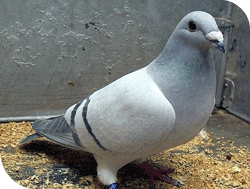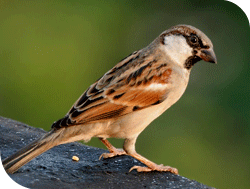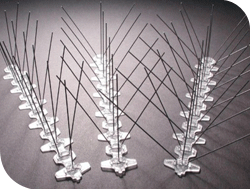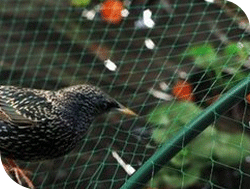
 A number of bird species may cause nuisance or damage problems in urban areas. These include crows,
A number of bird species may cause nuisance or damage problems in urban areas. These include crows,
house sparrows, pigeons and others
 House sparrows, pigeons, and crows cause problems around businesses, homes, public buildings
House sparrows, pigeons, and crows cause problems around businesses, homes, public buildings
and other structures because of their droppings, feeding, roosting, and nest building activities; associated
public health concerns; and other factors
 Droppings in water may lead to algae growth and possibly fish kills, and water contamination poses health
Droppings in water may lead to algae growth and possibly fish kills, and water contamination poses health
concerns, particularly when in municipal water supplies

 Pigeons typically have a gray body with a whitish rump, two black bars on the secondary wing feathers,
Pigeons typically have a gray body with a whitish rump, two black bars on the secondary wing feathers, Pigeons are primarily grain and seed eaters. They will also feed on garbage, livestock manure, insects,
Pigeons are primarily grain and seed eaters. They will also feed on garbage, livestock manure, insects, Pigeon droppings deface and accelerate the deterioration of buildings and increase the cost of maintenance
Pigeon droppings deface and accelerate the deterioration of buildings and increase the cost of maintenance Pigeon droppings deface and accelerate the deterioration of buildings and increase the cost of maintenance
Pigeon droppings deface and accelerate the deterioration of buildings and increase the cost of maintenance Pigeons may carry and spread diseases to people and livestock through their droppings.
Pigeons may carry and spread diseases to people and livestock through their droppings.
HOUSE SPARROWS

 Adult House Sparrows are small birds; 6–7 inches (15–17 cm) long with a 9-inch (23-cm) wingspan
Adult House Sparrows are small birds; 6–7 inches (15–17 cm) long with a 9-inch (23-cm) wingspan
 Male House Sparrows have gray bodies and brown backs streaked with black and can be easily recognized
Male House Sparrows have gray bodies and brown backs streaked with black and can be easily recognized
by the reddish-brown stripes above their white cheeks and by the black bib on their throat and upper chest
 Female House Sparrows are similar in appearance, with gray-brown bodies and brown backs streaked with black.
Female House Sparrows are similar in appearance, with gray-brown bodies and brown backs streaked with black.
However, the female has gray and brown streaks on both sides of her head above her cheeks
 The diet of the House Sparrow consists mainly of plant seeds, grains, birdseed, and human food scraps,
The diet of the House Sparrow consists mainly of plant seeds, grains, birdseed, and human food scraps,
except during the breeding season when they prey heavily on insects
 House Sparrows are highly social, roosting and nesting communally, but will fiercely defend small
House Sparrows are highly social, roosting and nesting communally, but will fiercely defend small
territories around nest sites
 House Sparrows build messy nests of dried vegetation in any available space around signs or under the eaves,
House Sparrows build messy nests of dried vegetation in any available space around signs or under the eaves,
gutters, and drain pipes of commercial buildings and residences. Their nests can damage insulation, cause
fire hazards , or clog drain pipes and gutters
 Their droppings often accumulate on the walls and sidewalks of businesses, creating an unsightly mess that
Their droppings often accumulate on the walls and sidewalks of businesses, creating an unsightly mess that
is unappealing to patrons and difficult to remove
 House Sparrows can carry a variety of zoonoses, diseases that can be spread to humans (often through feces),
House Sparrows can carry a variety of zoonoses, diseases that can be spread to humans (often through feces),
and act as amplifying hosts, allowing the infectious agent to multiply rapidly
Bird Spikes

 Bird spikes can be used to protect ledges, signs, beams, chimneys, cutouts, security cameras, lights,
Bird spikes can be used to protect ledges, signs, beams, chimneys, cutouts, security cameras, lights,
column tops and more from roosting pigeons, gulls and other large problem birds
 Pest birds such as pigeons and gulls like a flat surface to land on bird spike prevent them from
Pest birds such as pigeons and gulls like a flat surface to land on bird spike prevent them from
landing to gain a foothold
Bird Nets

 Bird netting is the strongest and most versatile bird exclusion system in the world.
Bird netting is the strongest and most versatile bird exclusion system in the world.
 Bird net denies pest birds access to literally any architectural configuration including courtyards, rooftops,
Bird net denies pest birds access to literally any architectural configuration including courtyards, rooftops,
overhangs, parking garages, etc.
When it comes to birds, there may be more than just avian flu to be worried about. It has been suggested that there are over 60 other diseases that birds and their droppings can carry. The problem is especially worrisome in residential areas, as many of them are airborne and can be transferred to humans just by being around droppings.
Common Pigeon Diseases
1. Canker
2. Lice
3. Flies
4. Coccidia
5. Worms
7. Hexamita
8. Mites
9. Chlamydia
Verminex® PEST CONTROL HAS BEEN PROVIDING EFFECTIVE SOLUTIONS FOR GETTING RID OF BIRDS. CONTACT US FOR ESTIMATE FOR YOUR HOME OR BUSINESS.